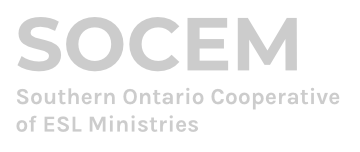This is an interactive ESL curriculum using the Hope film as its basis. The Hope Film is an overview of the Bible from Creation to the growth of the early church with narrators introducing each topic as scenes from feature films complement their explanations. The language is very clear and easy to understand. The ESL software program includes the entire film plus interactive English listening and speaking exercises.
The software is mainly for intermediate/advanced students working on their own, in pairs, or in small groups, but it can also be adapted for classroom use with an LCD projector to project the image onto a large screen. The curriculum is divided into 14 lessons. In my classes I have typically used the curriculum in the following way:
We begin by playing “Go Fish” using picture cards made from the scenes of the film we will be watching later in the class. Files of pictures are included in the program for each lesson. I print out the pictures and make a deck of “Go Fish” cards for each group. In groups of three to five, the students deal out four or five cards to each player and put the remaining cards in the “fish” pile. Next, they take turns going around the group asking questions about each others’ picture cards in order to find the cards that match the cards they have in their hands. If the person asked the questions has a matching picture card, she hands the card over, but if she doesn’t have a matching picture card, she tells the questioner to “go fish”, and the other person has to take an additional card from the fish pile. The first person to match all the cards in his hand wins the game. At the end of the game, each person holds up her matching pairs and describes the pictures to the group.
Following the game we go to the “Watch It” part of the lesson and watch the film segment the first time.For the second viewing of the film segment I hand out the script of the film with missing words and a word bank. They watch and listen and fill in the missing words. We take up the exercise and watch the segment a final time to give them a chance to read and follow along with the script of the film. After we have watched the film segment we discuss some questions about what we have seen and heard and do some vocabulary exercises. Click here to download the lesson sheets I prepared for this part.
If the group had difficulty understanding the film we go to the “Get It” part of the lesson and there the students can see and hear each sentence of the film script again. There is also a word bank in this part that lists the key words with their definitions and also a sound bite for pronunciation practice. Additionally, students can listen to native speakers giving descriptions of the various scenes from the film and get more information about the scenes.
My favourite part of the lesson is the “Own It” part. This part has five interactive games and quizzes. A laser pointer is useful for this part since it can be passed around the class easily as students take turns pointing to the right answers on the screen. The first game is called “Match the Picture” and up to fifteen pictures from the film segment are placed in a grid on the screen. A narrator describes one of the pictures and a student has to point to the picture described. We go around the class until all the pictures have been described. The next game is called “Order” and a list of six or seven phrases appear on the screen in a jumbled order. The narrator says the sentence and a student has to point out the correct order in which the phrases were spoken. The “Keyboard” exercise is basically spelling practice. After a keyboard appears on the screen, the narrator repeats a phrase or sentence and then repeats a key word from the sentence and tells the player to type the word using the keys on the screen keyboard. In all the activities, correct responses are rewarded with a happy beep and incorrect responses with a low buzz. Next on the list of “Own It” activities is the “Quiz”. Multiple choice questions appear on the screen and students choose the correct answer, a, b, c, or d. The final activity is called “Journey”. A scene from the film appears on the screen and then a command like, “Click on the eye of the camel” is given and a student then points to the eye of the camel to complete the task.
The “Use It” part of the lesson includes more activities, mainly for pairs and small groups, as well as discussion questions and selections from the Bible that relate to the chapter from the Hope film.
The “Other” part of each lesson has many more activities like crossword and word search puzzles which students can do individually on their computers at home or in a computer lab.
The authors have granted permission to copy and distribute the curriculum on CD. Since we cannot do all the activities in class, I give my students copies on CD (or share the link below) to take home for practice, usually after completing the curriculum
I highly recommend this innovative curriculum. You can download the Hope ESL Curriculum here.
—Colin Brewster
